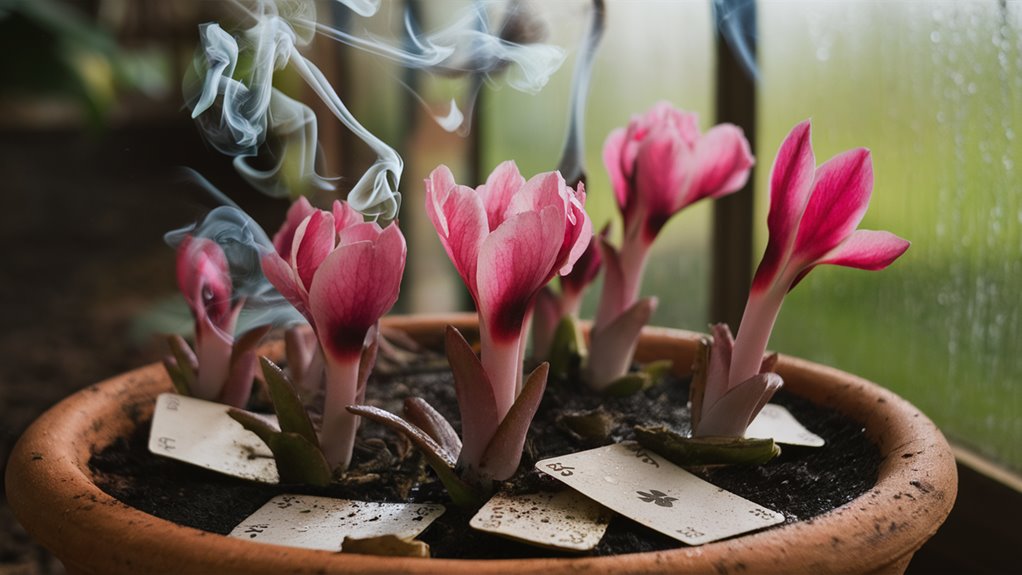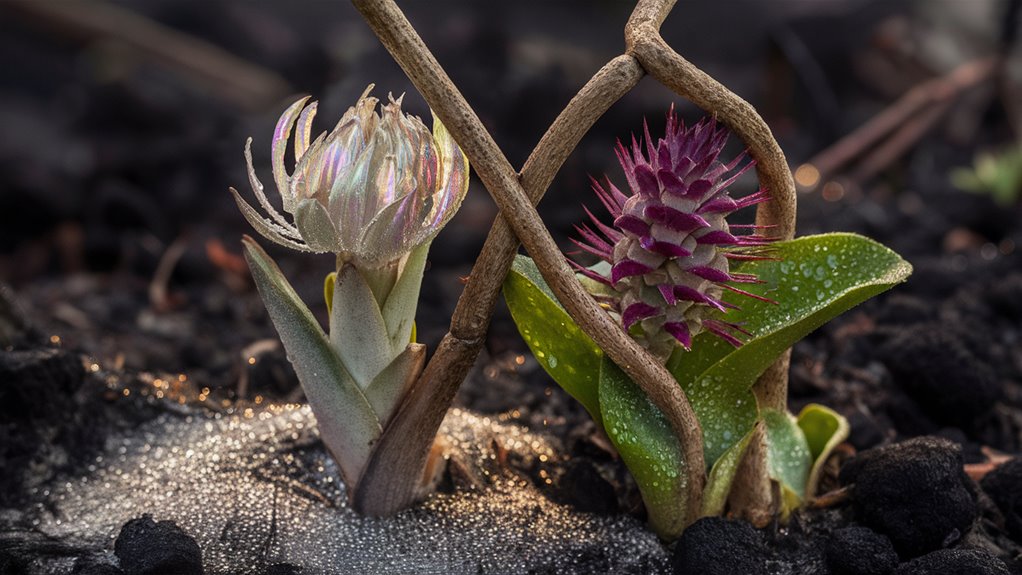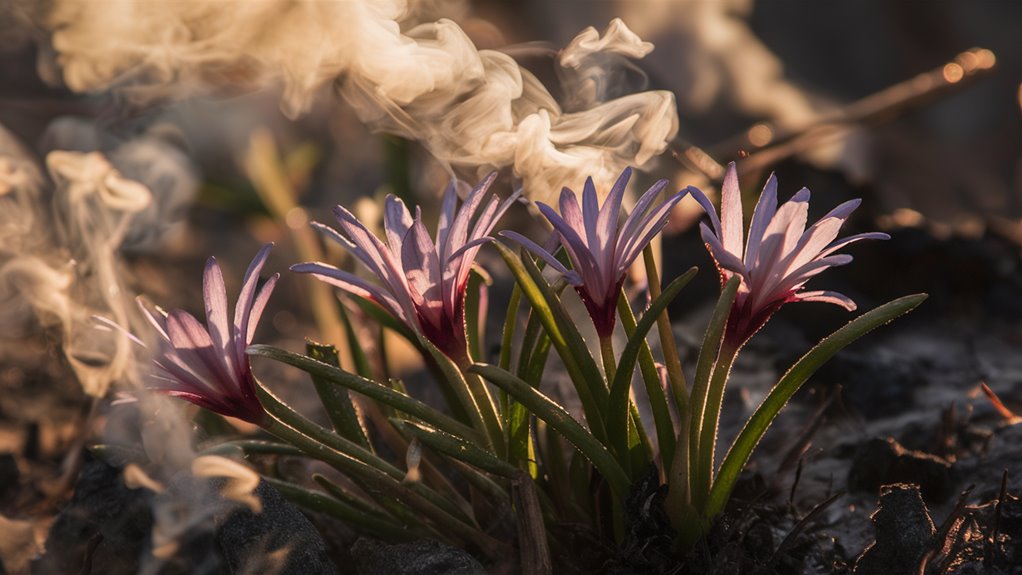Cinderblossom Poker: Expert Cultivation Guide
Essential Growing Techniques
The 35-degree poker technique stands as the cornerstone of successful cinderblossom cultivation, triggering multiple growth responses through precise stem manipulation. This method maximizes nutrient uptake and promotes robust development across all growth stages.
Optimal Environmental Parameters
Maintaining strict environmental controls proves crucial for cinderblossom success:
- Temperature: 65-75°F
- Humidity: 60%
- pH Levels: 6.2-6.8
Companion Planting Strategy
Strategic placement of companion species enhances cinderblossom vitality:
- Star Thistle: Natural protection barrier
- Moonglow Ferns: Moisture regulation
These companions create a balanced microecosystem supporting optimal growth.
Environmental Benefits
The distinctive smoky-gray foliage serves multiple ecological functions:
- Active pollutant filtration
- Pollinator habitat creation
- Enhanced biodiversity support
- Natural air purification
Sanctuary Development
Transform growing spaces into thriving ecosystems by integrating these botanical practices. The strategic combination of proper technique, environmental control, and companion planting establishes a self-sustaining growth environment.
The Science Behind Cinderblossom Poker

The Science Behind Cinderblossom Poker: A Comprehensive Guide
Understanding Plant Response Mechanisms
The foundation of Cinderblossom Poker techniques lies in mastering the delicate balance between natural energy flows and growth patterns.
Through precise stem manipulation, practitioners engage directly with auxin hormone distribution, triggering a cascade effect that optimizes growth energy throughout the plant's structure.
Core Scientific Principles
Three fundamental botanical responses drive successful Cinderblossom cultivation:
- Phototropism: Light-directed growth response
- Gravitropism: Gravity-influenced directional growth
- Thigmomorphogenesis: Touch-based structural adaptation
When executing the 35-degree poker technique, these responses activate simultaneously. The plant interprets this intervention as environmental stress, similar to natural conditions, strengthening cellular walls and optimizing nutrient distribution toward flowering sites.
Optimal Timing and Cellular Response
Peak transpiration periods, occurring approximately two hours post-sunrise, provide ideal conditions for poker application.
During this window, fully dilated stomata enable maximum nutrient flow. The technique creates strategic micro-tears in cellular structures, which heal to form enhanced nutrient pathways, ultimately producing the characteristic smoky-hued Cinderblossom formations.
Setting Up Your Botanical System

Complete Guide to Botanical System Setup
Essential Growing Medium Requirements
The foundation of successful Cinderblossom cultivation relies on a specialized growing medium incorporating volcanic ash and activated charcoal. These critical elements recreate the plant's natural habitat conditions.
Maintain a precise pH range of 6.2-6.8 to ensure optimal nutrient absorption and root development.
Three-Tier Growing System Architecture
Strategic vertical cultivation maximizes growth efficiency through a specialized three-tier design:
- Bottom Level: Primary container placement for stable temperature and humidity
- Middle Tier: Dedicated propagation zone
- Top Level: Mother plant cultivation area
Position full-spectrum LED grow lights 18 inches above each growing zone, maintaining a 16/8 light cycle for optimal photosynthesis.
Advanced Environmental Controls
Implement a precision irrigation system delivering specialized nutrient solutions containing:
- Magnesium-calcium mineral blend
- Essential trace elements
- Fine-mist humidity control (65-75% range)
Install oscillating air circulation systems and carbon filtration units to manage aromatic compounds.
Establish dedicated isolation zones between growth stages to preserve botanical lineage integrity and prevent cross-contamination.
Choosing the Right Plant Partners

Companion Planting Guide: Essential Plant Partners
Selecting Companion Plants
Companion planting is essential for creating a thriving garden ecosystem.
The key is pairing plants with complementary growth requirements and beneficial characteristics.
Strategic plant partnerships enhance soil health, deter pests, and optimize growing conditions.
Protective Plant Partners
Star Thistle serves as an excellent defensive perimeter plant. Its robust thorny structure naturally deters garden pests while its extensive root system improves soil structure.
Moonglow Ferns provide crucial partial shade and help maintain optimal moisture levels in the surrounding soil.
Soil Enhancement Companions
Nitrogen-fixing plants play a vital role in soil enrichment.
Position these beneficial plants strategically throughout the garden to improve soil fertility naturally.
Deep-rooted varieties create beneficial microhabitats while enhancing soil structure and nutrient availability.
Climate-Specific Ground Covers
In warmer growing zones, implement heat-resistant ground covers to regulate soil temperature. These plants serve multiple functions:
- Maintain soil moisture
- Suppress weed growth
- Release beneficial compounds
- Create protective microenvironments
Spacing and Density Guidelines
Plant three aromatic herbs per square meter to achieve optimal companion planting density. This spacing allows for:
- Proper air circulation
- Root development
- Resource sharing
- Natural pest control
Each companion group should be positioned to maximize beneficial interactions while avoiding resource competition.
Maintaining Optimal Growth Conditions

Optimal Growth Conditions for Plants
Essential Growing Requirements
Maintaining vibrant growth conditions requires careful attention to core plant needs.
Cinderblossom Poker plants thrive under specific environmental conditions, demanding a precise balance of light exposure, moisture levels, and nutrient management.
These plants require 6-8 hours of bright, indirect sunlight daily, while protecting them from intense afternoon sun that can damage delicate foliage.
Soil and Watering Guidelines
Proper soil moisture is fundamental for healthy growth. Monitor the top inch of soil – water thoroughly when it becomes dry.
The ideal growing medium maintains a pH level between 5.5 and 6.5 and contains rich organic matter for optimal nutrient absorption.
Environmental Controls
Temperature management plays a vital role in plant development. Maintain an ambient temperature range of 65-75°F (18-24°C).
Humidity levels should stay near 60%, achieved through regular misting or humidity tray placement.
Apply a balanced water-soluble fertilizer biweekly during active growth periods, reducing to monthly applications during dormancy.
Monitoring and Maintenance
Plant health indicators include leaf coloration, stem vigor, and growth rate.
Watch for signs of stress such as yellowing foliage, wilting, or stunted development.
Strategic pruning promotes dense growth patterns and enhances flowering performance. Adjust growing conditions promptly when stress signals appear to maintain optimal plant health.
Environmental Impact and Benefits

Environmental Impact and Benefits of Cinderblossom Poker Plants
Natural Environmental Benefits
Cinderblossom Poker plants deliver exceptional environmental advantages while enhancing local ecosystem health. These remarkable plants naturally filter atmospheric pollutants through their distinctive smoky-gray foliage, converting harmful particles into essential nutrients.
Their extensive root network system provides critical soil stabilization and improves groundwater retention throughout garden spaces.
Pollinator Support and Garden Enhancement
Cinderblossom Poker cultivation creates essential habitats for native pollinators. The vibrant poker-shaped blooms attract diverse pollinators including native bees, butterflies, and hummingbirds.
These beneficial plants release natural compounds that enhance the immune response of surrounding vegetation, resulting in improved garden resilience against pests and diseases.
Sustainability and Water Management
The environmental impact of Cinderblossom Poker extends to significant carbon sequestration capabilities, with their woody stems storing substantial carbon compared to typical perennials. These plants excel in rain garden applications, effectively filtering stormwater runoff and reducing pressure on municipal drainage infrastructure.
Their low-maintenance nature eliminates the need for chemical fertilizers or excessive irrigation, promoting sustainable gardening practices and environmental preservation.


